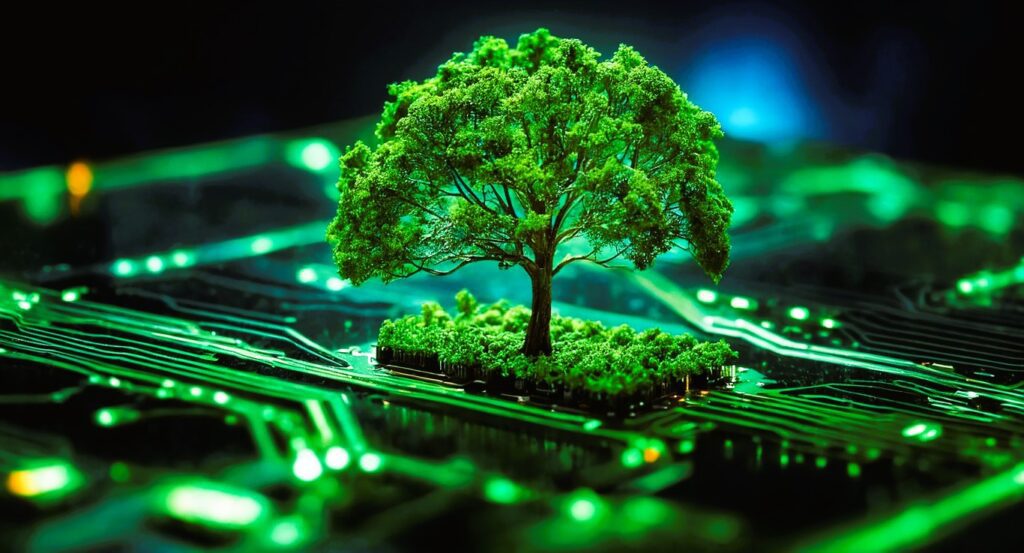Introduction to Green Technology
What is Green Technology?
Green technology, also known as environmental technology or clean technology, refers to the use of science and technology to reduce human impacts on the natural environment. It encompasses a wide range of practices and innovations designed to improve sustainability, including renewable energy sources, sustainable materials, and energy-efficient processes. The ultimate goal of green technology is to foster sustainable development that meets present needs without compromising the ability of future generations to meet theirs.
Importance and Benefits of Green Technology
Green technology is critical for mitigating climate change, reducing pollution, and conserving natural resources. It plays a crucial role in addressing global environmental challenges by promoting cleaner production methods, reducing waste, and enhancing energy efficiency.
The benefits include:
- Reduced Environmental Impact: Lower greenhouse gas emissions and reduced pollution.
- Resource Conservation: Sustainable use of natural resources to prevent depletion.
- Economic Growth: Creation of green jobs and promotion of sustainable industries.
- Improved Health: Reduction of harmful pollutants improves public health.
The Basics of Green Technology
Green technology includes a wide array of tools and systems designed to make human activities more sustainable. Here are some key areas:
- Renewable Energy: Solar panels, wind turbines, hydroelectric power, and bioenergy.
- Sustainable Materials: Biodegradable plastics, recycled materials, and sustainable textiles.
- Energy Efficiency: LED lighting, smart thermostats, and energy-efficient appliances.
- Water Conservation: Low-flow fixtures, rainwater harvesting systems, and wastewater treatment technologies.
- Waste Management: Recycling programs, composting, and waste-to-energy technologies.
Green Tech 101 Infographic
Solar Energy
Illustration:
A dynamic illustration showcasing a solar panel array, highlighting the photovoltaic (PV) cells.
Explanation:
Photovoltaic cells, or PV cells, convert sunlight directly into electricity. They are made of semiconductor materials, typically silicon, which absorb photons from sunlight, exciting electrons and creating an electric current.
Adoption Statistics:
Global Capacity: As of 2023, the global solar power capacity is over 1,000 gigawatts (GW).
Growth Trends: Solar energy has seen an average annual growth rate of 34% over the past decade.
Leading Countries: China, the United States, and India are leading in solar power installation, with China alone accounting for 35% of global solar capacity.
Cost Reduction: The cost of solar PV panels has decreased by over 80% since 2010, making it more accessible.
Real-Time Data (2024):
- Global Capacity: As of April 2024, the global solar power capacity has surpassed 1,200 GW.
- Growth Trends: Solar energy continues to grow rapidly, with an estimated 40% increase in capacity in the past year.
- Leading Countries: China remains the top solar power installer, followed by the United States and India.
Wind Energy
Diagram:
A detailed diagram of a wind turbine, showing its key components: rotor blades, nacelle, tower, and foundation.
Explanation:
Wind turbines convert the kinetic energy from wind into mechanical power, which can then be converted into electricity. The wind turns the blades around a rotor, which spins a generator to create electricity.
Data on Wind Power Capacity:
Global Capacity: By 2023, the global wind power capacity has reached approximately 837 GW.
Top Producers: The leading countries in wind power are China, the United States, and Germany.
Growth Trends: Wind energy has experienced significant growth, with a 10% increase in capacity each year over the past decade.
Offshore Wind Farms: Offshore wind farms are becoming more prevalent, with Europe and China leading in this sector, contributing significantly to the overall wind capacity.
Real-Time Data (2024):
- Global Capacity: As of April 2024, the global wind power capacity has exceeded 900 GW.
- Growth Trends: Wind energy capacity continues to expand, with an estimated 12% increase in the past year.
- Offshore Wind Farms: Investments in offshore wind farms have surged, with several new projects announced in Europe and Asia.
Electric Vehicles (EVs)
Image:
A sleek image of an electric car, highlighting the charging port and battery pack.
Details on Battery Technology:
Electric vehicles use lithium-ion batteries, which are favored for their high energy density, long cycle life, and decreasing costs. Advances in battery technology continue to improve the range, charging time, and overall performance of EVs.
Growth Trends:
Global EV Sales: In 2023, global electric vehicle sales surpassed 10 million units, reflecting a 30% increase from the previous year.
Market Share: Electric vehicles now represent about 14% of all new car sales globally.
Leading Markets: China, Europe, and the United States are the largest markets for electric vehicles, with China leading in both production and sales.
Charging Infrastructure: The number of public EV charging stations has grown by 60% annually, with significant investments from both governments and private companies.
Real-Time Data (2024):
- Global EV Sales: As of March 2024, global electric vehicle sales have reached 12.5 million units, indicating a steady growth trajectory.
- Market Share: Electric vehicles continue to gain market share, comprising approximately 16% of new car sales worldwide.
- Charging Infrastructure: The expansion of public EV charging stations has accelerated, with a 70% increase in the past year, driven by government initiatives and private investments.
Emerging Trends and Innovations in Green Technology
The Future of Green Tech
The landscape of green technology is continuously evolving. Here are some emerging trends and innovations that could revolutionize industries:
- Energy-Positive Buildings: Structures that generate more energy than they consume using solar windows and algae-based bio facades.
- Biodegradable Plastics: Advanced materials that decompose naturally, reducing plastic pollution.
- Smart Grids: Enhanced electrical grids that use digital technology to optimize energy distribution and consumption.
Startup Spotlight
Highlighting innovative green tech startups can showcase the potential of new technologies:
- Example: “Company X has developed a revolutionary battery that allows electric vehicles to travel 500 miles on a single charge, making them a viable alternative to gas-powered cars.”
Success Stories and Case Studies
Green Tech in Action
Real-world implementations of green technology demonstrate its effectiveness:
- Example: “The city of Barcelona’s smart traffic management system has reduced congestion and emissions by 20%. Using sensors and real-time data analytics, the system optimizes traffic light timing and provides drivers with the most efficient routes.”
Company Goes Green
Businesses adopting green technologies significantly impact their environmental footprint:
- Example: “Tech giant Google has powered 100% of its operations with renewable energy for the past three years, thanks to substantial investments in wind and solar farms.”
Challenges and Solutions in Green Technology
Overcoming Green Tech Hurdles
Adopting green technology comes with challenges, but solutions are available:
- Example: “While the cost of solar panels has decreased dramatically, upfront installation costs remain a barrier for many homeowners. Innovative financing models and government incentives can help make green tech more accessible.”
Addressing E-Waste
The growing issue of electronic waste can be mitigated with green tech:
- Example: “Designing devices and batteries with recyclability in mind, as well as implementing take-back programs and e-waste recycling facilities, are crucial for reducing the environmental impact of our increasingly digital lives.”
Policy and Advocacy for Green Technology
The Role of Policy in Green Tech
Government regulations and incentives significantly impact green technology development:
- Example: “Net metering laws, which allow households to sell excess solar power back to the grid, have been instrumental in encouraging the adoption of rooftop solar. Strengthening and expanding these policies could further accelerate the renewable energy transition.”
Advocating for a Greener Future
Consumers and citizens can play a vital role in promoting green technology:
- Example: “As consumers, we have the power to demand more sustainable practices from the companies we support. Let’s use our purchasing power to drive the demand for green tech and hold our elected officials accountable for taking bold climate action.”
Lifestyle and Consumer Focus
Green Tech for the Home
Homeowners can implement various green technologies to make their lives more sustainable:
- Example: “Smart thermostats can learn your temperature preferences and schedule to optimize heating and cooling, reducing energy waste. Meanwhile, energy monitoring systems provide real-time feedback on your home’s energy usage.”
Eco-Friendly Product Roundup
A curated list of green tech products can help consumers live more sustainably:
- Example: “From reusable stainless steel straws to portable power banks powered by solar panels, there are countless green gadgets that can make a big impact when combined with conscious daily habits.”
Future Trends in Green Technology Services
Emerging Technologies
- Carbon Capture and Storage
- Direct Air Capture: Extracting CO2 directly from the atmosphere.
- Geological Sequestration: Storing captured CO2 underground.
- Hydrogen Energy
- Green Hydrogen Production: Using renewable energy to produce hydrogen.
- Fuel Cells: Hydrogen fuel cells for clean energy.
Innovations in Energy Storage
- Solid-State Batteries
- Higher Energy Density: Offering more power storage in a smaller space.
- Improved Safety: Reducing risks of overheating and fires.
- Grid-Scale Storage
- Flow Batteries: Using liquid electrolytes for large-scale energy storage.
- Compressed Air Energy Storage: Storing energy in the form of compressed air.
Benefits of Green Technology Services
| Environmental Benefits | Economic Benefits | Health Benefits |
| Reduced greenhouse gas emissions: Green technology helps lower the amount of carbon dioxide and other harmful gasses released into the atmosphere, contributing to climate change mitigation. | Creation of green jobs: The development and implementation of green technologies create new employment opportunities in sectors like renewable energy, sustainable construction, and environmental protection. | Improved air and water quality: Green technologies reduce pollutants, leading to cleaner air and water, which is essential for public health. |
| Lower pollution levels: Innovations such as electric vehicles and renewable energy sources reduce air and water pollution, leading to healthier ecosystems. | Growth of sustainable industries: Green technology promotes the growth of industries focused on sustainability, which can lead to a more resilient and diverse economy. | Reduced exposure to harmful pollutants: By minimizing pollutants, green technology reduces the risk of health issues related to air and water contamination, such as respiratory and cardiovascular diseases. |
| Conservation of natural resources: Green technologies, like water-saving devices and renewable energy, help conserve vital natural resources, ensuring their availability for future generations. | Long-term cost savings: While the initial investment in green technology can be high, the long-term savings from energy efficiency and reduced resource consumption often outweigh the costs. | Enhanced public health outcomes: The overall reduction in pollutants and improved environmental quality can lead to better health outcomes, reducing healthcare costs and improving quality of life. |
This table provides a clear, categorized overview of the benefits of green technology services, highlighting the advantages in terms of environmental, economic, and health impacts.
Conclusion
Green technology is essential for sustainable development, offering numerous environmental, economic, and health benefits. By understanding its basics, staying informed about emerging trends, and supporting policies that promote green tech, we can collectively work towards a greener, more sustainable future.








